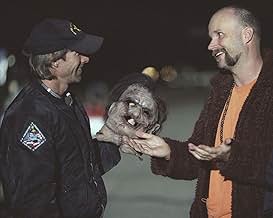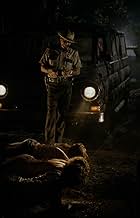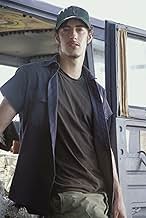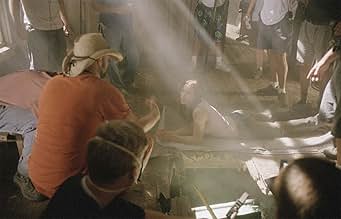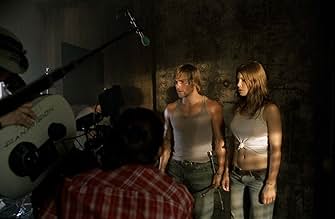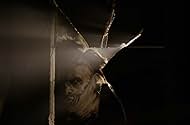Après avoir pris en stop un jeune homme traumatisé, cinq amis se retrouvent traqués et chassés par un homme brandissant une tronçonneuse et sa famille de tueurs tout aussi psychopathes.Après avoir pris en stop un jeune homme traumatisé, cinq amis se retrouvent traqués et chassés par un homme brandissant une tronçonneuse et sa famille de tueurs tout aussi psychopathes.Après avoir pris en stop un jeune homme traumatisé, cinq amis se retrouvent traqués et chassés par un homme brandissant une tronçonneuse et sa famille de tueurs tout aussi psychopathes.
- Récompenses
- 4 victoires et 17 nominations au total
John Larroquette
- Narrator
- (voix)
Scott Martin Gershin
- Leatherface
- (voix)
- (non crédité)
Harry Jay Knowles
- Victim On a Silver Platter
- (non crédité)
Histoire
Le saviez-vous
- AnecdotesA then-unknown John Larroquette provided the narration in the original Massacre à la tronçonneuse (1974). Despite becoming a distinguished actor in the years since, he happily agreed to reprise his role for the remake.
- GaffesThe young group is listening to "Sweet Home Alabama" by Lynyrd Skynyrd in the van at the beginning of the film. The film takes place between 18 and 20 August 1973. The song was not released until 1974, featured on the band's album, "Second Helping".
- Citations
Sheriff Hoyt: I smell bullshit.
- Versions alternativesOriginally was slapped with an 'NC-17' rating by the MPAA, cuts were made for an 'R'.
- Hitchhiker's gunshot suicide reduced blood and brain guts, and a severed ear landing on Pepper's lap.
- Morgan's death reduced a wide shot of chainsaw cutting him from below, blood splattering on the floor and his insides falling between his legs.
- ConnexionsFeatured in Motograter: Suffocate (2003)
- Bandes originalesSweet Home Alabama
Written by Edward King (as Edward C. King), Ronnie Van Zant and Gary Rossington
Performed by Lynyrd Skynyrd
Courtesy of MCA Records
Under license from Universal Music Enterprises
Commentaire à la une
The horror/sci-fi movie critic Richard Scheib coined the term "Backwoods Brutality" to describe the slew of low-budget movies that emerged in the 1970s which had as their main theme the violent and abrupt destruction of middle-class serenity. The concept has occasionally found expression outside of the horror genre (Straw Dogs, Deliverance), but since Wes Craven's Last House on the Left (1972), it has been a mainstay of the horror genre. Even thirty years later, the basic idea continues to be remade and re-interpreted.
In my view, the original Texas Chainsaw Massacre (1974) is the most successful exponent of the genre. As it often is in the American variations of this genre, the TCM takes the so-called blue state/red state dichotomy to a grotesque extreme: the backroads of the Deep South is another country and its inhabitants exhibit uncontained contempt for every unsuspecting wayfarer. Its use of tension, which is meticulously established in the movie's first 45 minutes, and release -- the last 45 minutes -- is almost elegant in its simplicity. Throughout, violence is used in sparing and sudden bursts until the adrenaline-fueled final act, during which it is mercilessly sustained.
With some minor qualifications, this description also fits Marcus Nispel's 2003 remake. Here the enlarged budget and technical expertise have worked both for and against the film. On the one hand, a variety of new elements have been added to the story. Some, like the mysterious little boy or the ending, are so-so, while others, like Leatherface's skin mask or the "extended family," are effective. On the other hand, the professionalism and attention to detail demonstrated by Nispel and Daniel Pearl (whose cinematography here is magnificent) on down to those responsible for filming locations and set detail, is consistently impressive.
So the basic "tension-release" framework has been lifted from the original but instead of improving on it the filmmakers have saddled it with characters, situations, drama, and violence. (We learn from the DVD extras, happily, that some "tender moments" were left on the cutting room floor.) I give it a 7 because ultimately I think it works as a horror movie on its own terms -- in fact, I don't think a better American horror movie has been made since 2000 -- and Nispel/Kosar deserve credit attempting to revise the concept in minor ways for fans of the franchise. On the balance, however, the original's low-budget guerilla-like realism as well as some of its visceral power has been compromised.
Of note, finally, is the performance of Jessica Biel. Having earned her acting chops on the Christian TV show/cheesefest, Seventh Heaven, Biel has as of late found a niche playing physically tough, but likable and intelligent characters. She's quite excellent here; as it was for the original TCM's Marilyn Burns, Biel's performance is exhilarating and intense -- a kind of endurance test. But one easily believes she has the acuity and toughness to survive the ordeal.
In my view, the original Texas Chainsaw Massacre (1974) is the most successful exponent of the genre. As it often is in the American variations of this genre, the TCM takes the so-called blue state/red state dichotomy to a grotesque extreme: the backroads of the Deep South is another country and its inhabitants exhibit uncontained contempt for every unsuspecting wayfarer. Its use of tension, which is meticulously established in the movie's first 45 minutes, and release -- the last 45 minutes -- is almost elegant in its simplicity. Throughout, violence is used in sparing and sudden bursts until the adrenaline-fueled final act, during which it is mercilessly sustained.
With some minor qualifications, this description also fits Marcus Nispel's 2003 remake. Here the enlarged budget and technical expertise have worked both for and against the film. On the one hand, a variety of new elements have been added to the story. Some, like the mysterious little boy or the ending, are so-so, while others, like Leatherface's skin mask or the "extended family," are effective. On the other hand, the professionalism and attention to detail demonstrated by Nispel and Daniel Pearl (whose cinematography here is magnificent) on down to those responsible for filming locations and set detail, is consistently impressive.
So the basic "tension-release" framework has been lifted from the original but instead of improving on it the filmmakers have saddled it with characters, situations, drama, and violence. (We learn from the DVD extras, happily, that some "tender moments" were left on the cutting room floor.) I give it a 7 because ultimately I think it works as a horror movie on its own terms -- in fact, I don't think a better American horror movie has been made since 2000 -- and Nispel/Kosar deserve credit attempting to revise the concept in minor ways for fans of the franchise. On the balance, however, the original's low-budget guerilla-like realism as well as some of its visceral power has been compromised.
Of note, finally, is the performance of Jessica Biel. Having earned her acting chops on the Christian TV show/cheesefest, Seventh Heaven, Biel has as of late found a niche playing physically tough, but likable and intelligent characters. She's quite excellent here; as it was for the original TCM's Marilyn Burns, Biel's performance is exhilarating and intense -- a kind of endurance test. But one easily believes she has the acuity and toughness to survive the ordeal.
- Eikonoklast
- 28 sept. 2005
- Permalien
Meilleurs choix
Connectez-vous pour évaluer et suivre la liste de favoris afin de recevoir des recommandations personnalisées
Détails
- Date de sortie
- Pays d’origine
- Langue
- Aussi connu sous le nom de
- La masacre de Texas
- Lieux de tournage
- Taylor Meat Company, Taylor, Texas, États-Unis(Blair Meat Company)
- Sociétés de production
- Voir plus de crédits d'entreprise sur IMDbPro
Box-office
- Budget
- 9 500 000 $US (estimé)
- Montant brut aux États-Unis et au Canada
- 80 571 655 $US
- Week-end de sortie aux États-Unis et au Canada
- 29 100 000 $US
- 19 oct. 2003
- Montant brut mondial
- 107 364 583 $US
- Durée1 heure 38 minutes
- Couleur
- Mixage
- Rapport de forme
- 1.85 : 1
Contribuer à cette page
Suggérer une modification ou ajouter du contenu manquant

Lacune principale
What is the Japanese language plot outline for Massacre à la tronçonneuse (2003)?
Répondre


